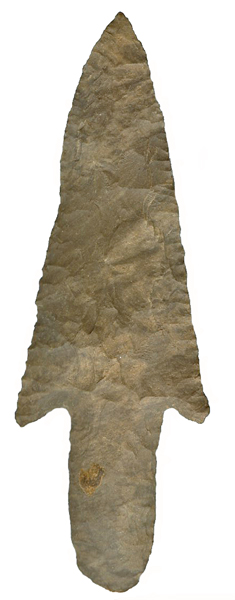

Point Type: ADENA
- WAUBESA
Also See: Adena, Adena Narrow Stem, Adena -
Notched Base, Adena - Robbins, Adena - Wells, Cypress Stemmed, Dickson, Gary
, Little
Bear Creek, Turkeytail - Hebron
Location: Eastern United States
Associated Dates: 2700 - 1200 B.P. - Woodland
Morphology: Stemmed
General Description: The Adena -
Waubesa dart point and
knife blade is a medium to large sized point with
a contracting
stem. The blade is triangular has straight
to convex
edges and is widest at the shoulders which are seldom weakly barbed
to angular. The stem contracts convexly to a
rounded end and is wider and longer than those on the Gary point
type.
Chipping was performed by
percussion with removal of
broad, flat flakes followed by very careful retouch of the blade edges. Cross section
is uniformly lenticular. Stem edges may have no
edge treatment, may be smoothed occasionally,
but are rarely ground.
The
distribution range of the Adena - Waubesa point type is Ohio, Indiana,
Michigan, Wisconsin, Illinois, Iowa, Missouri, Arkansas, Oklahoma, Kansas,
Nebraska and eastern Colorado.
The Waubesa points were made by the early Woodland Black
Sand Culture in Illinois and the Middle Woodland Hopewell Culture. The
point appears to have continued to be made by the early Late Woodland people of
Illinois, buth the major period of their manufacture was during the Hopewell
era. Almost identical points were made by the Adena people in Ohio and
Kentucky. A similar point was made by Late Archaic people in Illinois,
Missouri and Indiana but can be separated in that they have ground stem edges
and the shoulders contract with the stem. The point is very difficult to
separate from the Adean point type. Waldorf reports that the Waubesa has
been found with Snyders and Dickson points in Illinois and Missouri.
Most Waubesa point from Illinois and
eastern Missour were made from heat treated Crescent and Burlington cherts. Those from
the Ozark Hill region were made of white or light colored cherts most of
which were heat treated. Examples from Tennessee are typically made from Dover cherts
and those from Indiana were made from Inidana hornstone.
Waubesa points have the largest distribution in the
Hopewell period extending westward across Kansas into eastern Colorado and then
eastward into Ohio.
The size
range of the Waubesa is from 75 mm to 152 mm
in length with the average being 101 mm.
The Waubesa is
a companion and alternate form of Winters' Dickson Broad-Blade point which he
believes was often used as a knife.
The Waubesa point type was named by
David Baerreis and was described by Robert Ritzenthaler in 1967 in his Guide
to Wisconsin Indian Projectile Point Types.
About the Point Above:
The average sized Adena - Waubesa blade with very long stem, pictured at
the top of this page, was found in Smith County, Tennessee. The
point is made from a dull tan and brown banded Dover
chert and is heavily patinated. The blade is very thin and well made with fine retouch
along the blade edges. Overall, the point measures 92 mm in length, is 33 mm wide across
the shoulders, and is only 5 mm thick in mid blade.
The stem is 29 mm long and is 14 mm wide in mid stem The
stem is mildly smooted at the edges and is 7.1 mm thick at mid stem. Catalog Number 160-125-V
References: Hranicky (1), Justice (1), Overstreet, Perino (1, 4), Waldorf
© Copyright 1997 - 2008 LITHICS-Net WWW.LITHICSNET.COM
Use your Browser's BACK Button to return to the LITHICS-Net Index.